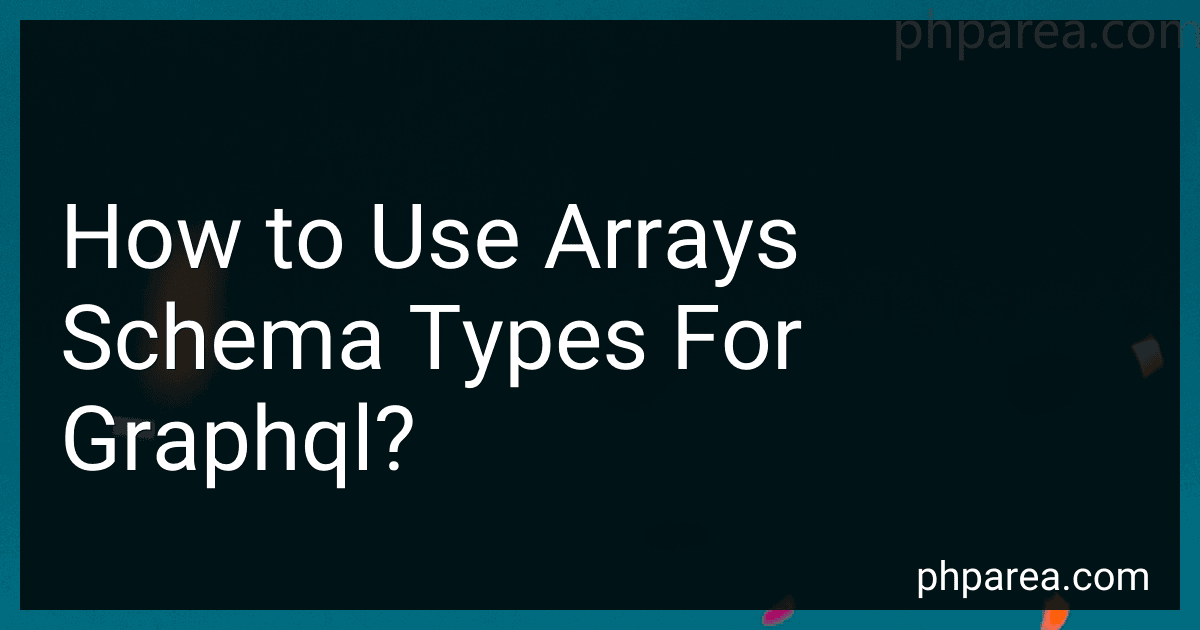Best Array Schema Tools to Buy in December 2025
Schema types are an essential part of defining the structure of GraphQL queries and mutations. One common way to define schema types in GraphQL is through the use of arrays. Arrays allow you to store multiple values of the same type within a single field.
To use arrays schema types in GraphQL, you can simply define a field in your schema with the desired type followed by square brackets. For example, if you want to create a field that returns an array of integers, you would define it as follows:
type Query { numbers: [Int] }
In this example, the field "numbers" will return an array of integers when queried. You can also define nested arrays by using multiple sets of square brackets. For instance, if you want to store an array of arrays of integers, you could define a field like this:
type Query { listOfLists: [[Int]] }
Arrays in GraphQL schema types offer flexibility in defining data structures and enable you to work with collections of data effectively. By using arrays schema types, you can represent one-to-many relationships, lists of values, and more complex data structures within your GraphQL API.
How to define an array type in GraphQL schema?
In a GraphQL schema, you can define an array type by using square brackets around the type. For example, if you want to define an array of strings, you would do so like this:
type Query { names: [String] }
This would define a field names in the Query type that returns an array of strings. You can also define arrays of custom types by replacing String with the custom type name.
What is a schema type in GraphQL?
A schema type in GraphQL defines the shape of the data that can be queried and retrieved from a GraphQL server. It consists of object types, input types, interface types, union types, enum types, scalar types, and directive types. The schema type acts as a contract between the client and the server, specifying the available fields, relationships, and data types that can be requested and returned in a GraphQL query. By defining a schema type, developers can ensure that the data retrieval process is consistent and predictable for both clients and servers interacting with a GraphQL API.
What is the role of arrays in resolving complex nested relationships in GraphQL?
Arrays play a crucial role in resolving complex nested relationships in GraphQL by allowing developers to represent and query data structures that have multiple levels of nesting.
For example, in a nested relationship where a user has multiple posts and each post has multiple comments, arrays can be used to represent the multiple posts and comments associated with each user. This allows developers to query for specific data within these nested relationships by specifying which fields they want to retrieve at each level of nesting.
Arrays in GraphQL provide a way to structure and organize data in a flexible and efficient manner, making it easier to work with complex nested relationships and reducing the need for multiple queries or additional data fetching logic. This allows developers to easily navigate and access data at different levels of nesting, providing a more intuitive way to interact with nested relationships within the GraphQL schema.
How to implement pagination with arrays in GraphQL queries?
To implement pagination with arrays in GraphQL queries, you can use the slice method on the array in your resolver function. Here's a basic example of how to implement pagination with arrays in GraphQL:
- Modify your GraphQL schema to include pagination parameters (such as first and after) in the query:
type Query { users(first: Int, after: String): [User!]! }
- In your resolver function for the query, use the slice method to paginate the array of users based on the first and after parameters:
Query: { users: (_, {first, after}, {dataSources}) => { let users = dataSources.userAPI.getUsers();
if (after) {
const index = users.findIndex(user => user.id === after);
users = users.slice(index + 1);
}
return users.slice(0, first);
}
}
In this example, the getUsers method returns an array of all users. If the after parameter is provided, it finds the index of the user with that ID in the array and starts slicing from the next index. Then it slices the array to return only the specified number of users given in the first parameter.
- In your GraphQL query, you can now specify the pagination parameters to retrieve a subset of the array:
query { users(first: 5, after: "userId123") { id name email } }
This query will return the first 5 users that come after the user with the ID "userId123" in the array, allowing you to implement pagination with arrays in GraphQL queries.
What is the recommended way to pass arrays in GraphQL queries?
In GraphQL, arrays can be passed as arguments in queries using input objects or variables. Input objects are used to pass multiple arguments as a single object in the query, making the query more readable and maintainable. Variables can be used to pass dynamic values to the query, including arrays.
Here's an example of passing an array as a variable in a GraphQL query:
query GetBooks($ids: [ID!]!) { books(ids: $ids) { title author } }
In this query, the $ids variable is defined as an array of IDs that will be passed to the books field. The ! after the type (ID) indicates that the array cannot be null.
When executing the query, the array can be passed as a variable:
{ "ids": ["1", "2", "3"] }
This approach allows for passing arrays of different types or lengths dynamically in GraphQL queries.



